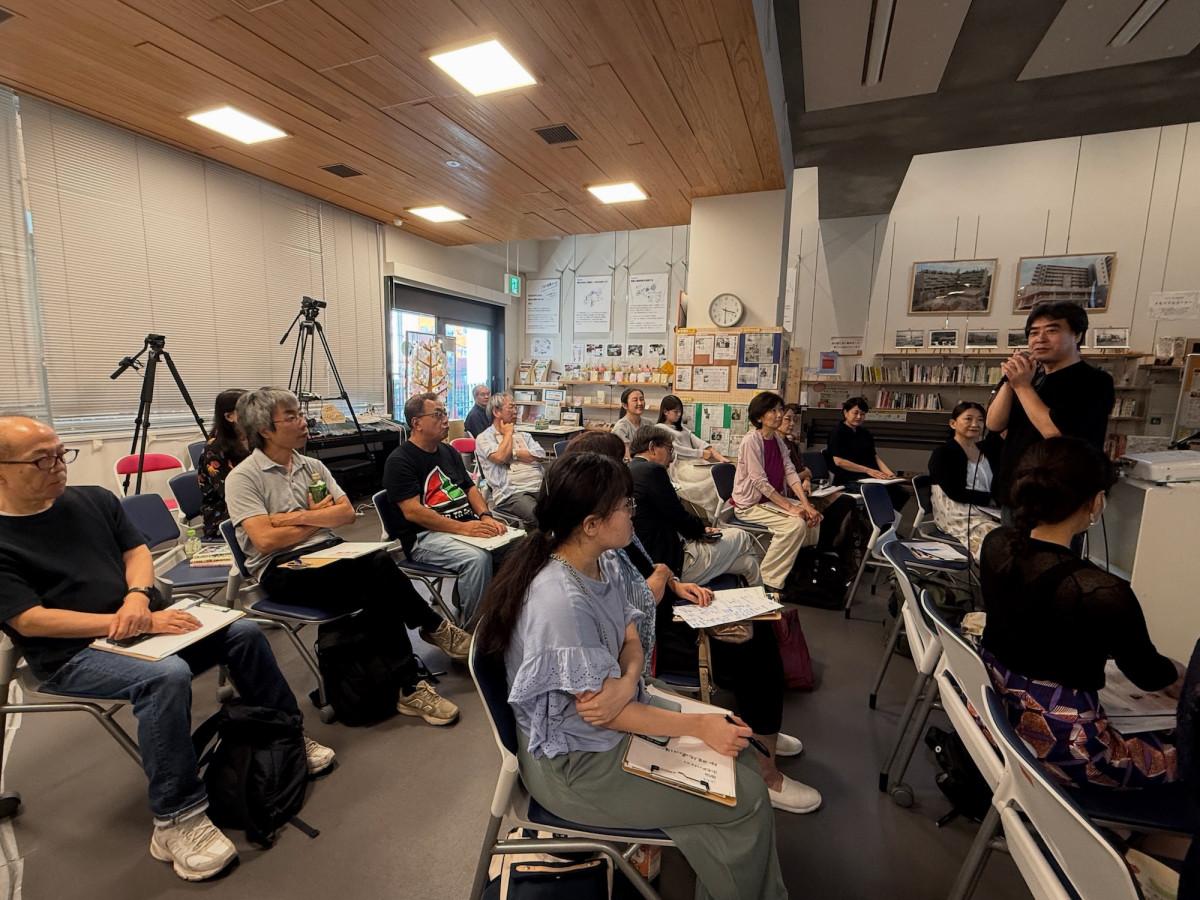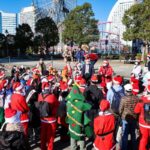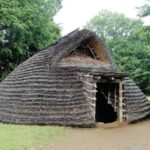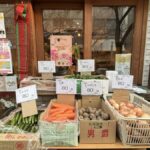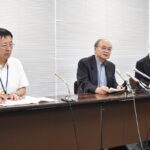Takato Arai (right)
On August 2, a talk event titled “When Poetry Rises in the City” was held at the Yokohama Kotobuki Collaborative Space (4 Kotobuki-cho, Naka-ku, Yokohama), featuring Takato Arai, the representative of the Maebashi Poetry Festival. This event was part of the regional poetry project “Rinjo – Singing the Yokohama Within Me,” led by the NPO “Yokohama Community Design Lab” (3 Aioi-cho, Naka-ku).
The Rinjo Project is an initiative that traces local memories through poetry readings and workshops, encouraging dialogue among residents. It has been selected for the 2025 Yokohama Regional Culture Support Program by the Yokohama Arts Foundation.
Arai began writing poetry during his student years and resumed at the age of 35. Initially active within poet circles, he gradually felt a sense of stagnation and loneliness. “While calling myself a poet, I wanted to blend into the city and create connections,” he said, leading him to step out into the streets in search of “a place where I could be myself.”
After joining the art school at the Maebashi City Museum of Art “Arts Maebashi,” Arai was deeply influenced by former Towada Art Museum director Hiroshi Fuji’s words, “Create not objects, but relationships.” This inspired him to co-found “Mebu,” an adult club activity group that became the foundation for organizing the Maebashi Poetry Festival.
During the talk, Arai discussed the origins of the Maebashi Poetry Festival, its decade-long continuity, how poetry connects communities, and the legacy of Maebashi-affiliated poet Sakutaro Hagiwara.
The festival features diverse events over two weeks, including poetry readings by 30 participants at the Maebashi Literature Museum and a “Town Exhibition” displaying collaborative works of poetry and photographs themed around “hometown” in 50 local shops. These efforts have attracted fans from across Japan. Activities like the “Sunday Morning Reading Sessions” at the Maebashi Literature Museum and the long-running “Maebashi Poetry School” make poetry and readings easily accessible in Maebashi, a city known as “the town of water, greenery, and poetry.”
In the latter half of the event, collaboration artists “Nitehi Works” presented examples of their work. Participants were also invited to join a four-part poetry workshop starting on August 17. The Rinjo Project coordinator remarked, “We gained many insights for the ‘Rinjo’ project in Yokohama. We aim to visualize local voices and rediscover the city’s charm.”
Yokohama Kotobuki Collaborative Space
The Yokohama Kotobuki Collaborative Space is a community-oriented facility in Yokohama, Japan, designed to foster social inclusion and support for marginalized groups, including homeless individuals and day laborers. Established in the Kotobuki district—an area historically known for its *yoseba* (day laborer gathering spot)—the space provides access to resources, workshops, and collaborative projects aimed at empowerment and integration. It reflects efforts to address urban poverty while revitalizing community ties in a historically challenged neighborhood.
Yokohama Community Design Lab
The Yokohama Community Design Lab is a collaborative space in Yokohama, Japan, established to foster urban innovation and community engagement through design. Founded in the early 2000s, it serves as a hub for residents, designers, and policymakers to co-create solutions for local challenges, reflecting Yokohama’s history as a port city open to cultural exchange. The lab emphasizes participatory planning and creative placemaking, contributing to the city’s dynamic urban development.
Maebashi Poetry Festival
The Maebashi Poetry Festival is an annual cultural event held in Maebashi, Gunma Prefecture, Japan, celebrating poetry and literary arts. Established to honor the city’s rich literary heritage—including its connection to famous poets like Sakutaro Hagiwara—the festival features readings, workshops, and performances. It promotes contemporary and traditional poetry, fostering creativity and community engagement.
Maebashi City Museum of Art “Arts Maebashi”
The Maebashi City Museum of Art, also known as *Arts Maebashi*, is a contemporary art museum located in Maebashi, Gunma Prefecture, Japan. Established in 2017, it focuses on modern and contemporary art, featuring exhibitions by both Japanese and international artists. The museum also emphasizes community engagement, offering workshops and interactive programs to connect art with the public.
Towada Art Museum
The Towada Art Museum, located in Towada City, Aomori Prefecture, Japan, is a contemporary art museum that opened in 2008 as part of the city’s efforts to revitalize through art. It features large-scale installations and works by renowned artists like Yayoi Kusama and Ron Mueck, blending indoor and outdoor exhibition spaces. The museum is known for its innovative design and integration with the surrounding urban landscape, offering a unique cultural experience in northern Japan.
Maebashi Literature Museum
The Maebashi Literature Museum, located in Maebashi City, Gunma Prefecture, Japan, celebrates the region’s rich literary heritage. It honors notable writers associated with the area, such as Sakutaro Hagiwara, a prominent poet of modern Japanese literature. The museum features exhibits on their works, personal artifacts, and hosts cultural events to promote literary appreciation.
Sakutaro Hagiwara
Sakutaro Hagiwara (1886–1942) was a renowned Japanese poet, often called the “father of modern free-verse poetry in Japan.” He is best known for his melancholic and introspective style, exemplified in works like *Tsuki ni Hoeru* (“Howling at the Moon”). His poetry broke from traditional forms, influencing generations of writers. While not a physical site, his legacy is celebrated in literary circles and cultural institutions across Japan.
Nitehi Works
Nitehi Works appears to be a lesser-known cultural or industrial site, and there is limited widely available historical information about it. If it pertains to a specific local or regional context, it may have significance in craftsmanship, manufacturing, or community heritage. For a more accurate summary, additional details about its location or historical background would be helpful. Let me know if you’d like assistance in researching it further!

